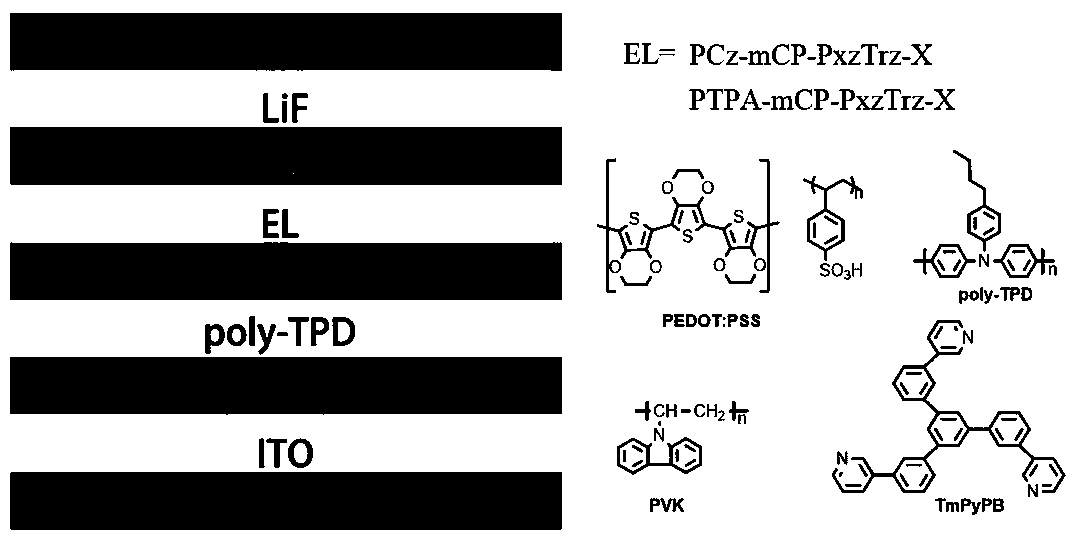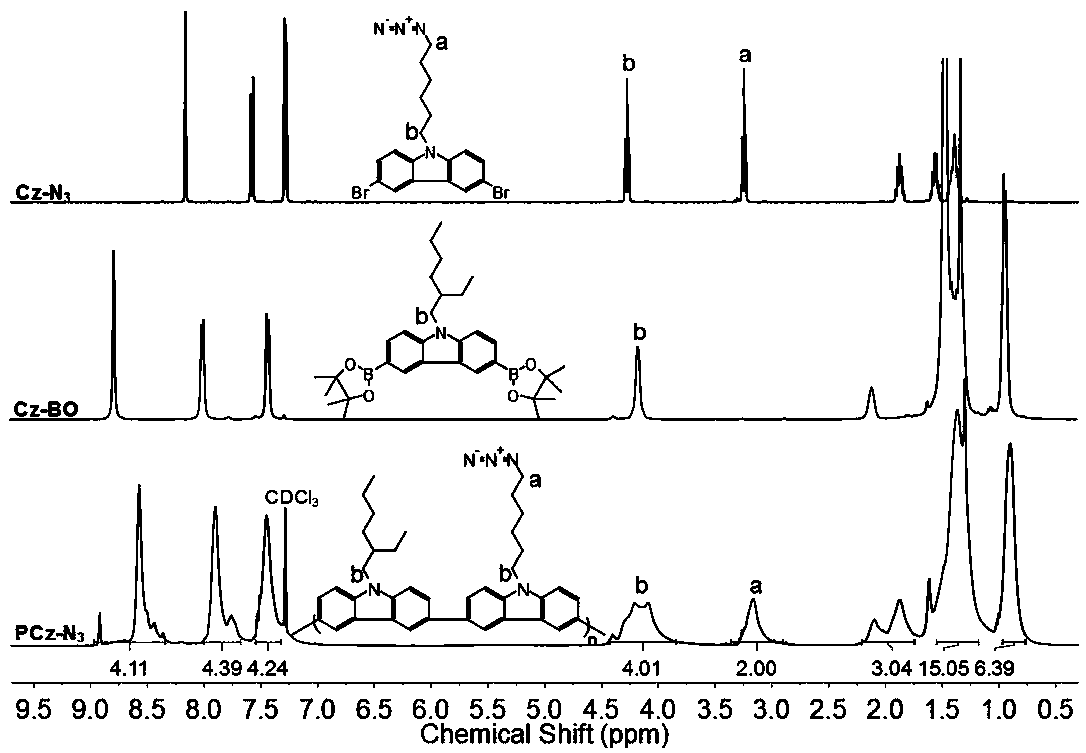Autonomous three dimensional polymer TADF luminescent material as well as preparation method and application thereof
A technology of bulk polymers and luminescent materials, applied in the fields of luminescent materials, chemical instruments and methods, semiconductor/solid-state device manufacturing, etc., can solve the problems of difficult to obtain high molecular weight target products, difficult to control the content of functional components, phase separation, etc. Achieve good application prospects, excellent device performance, and avoid concentration quenching effects
- Summary
- Abstract
- Description
- Claims
- Application Information
AI Technical Summary
Problems solved by technology
Method used
Image
Examples
Embodiment 1
[0065] Self-hosted TADF light-emitting polymer PCz-mCP-PxzTrz-X (X=0,10,20,30 or 40, wherein X is the percentage of PxzTrz-Alk in two alkyne-containing functional compounds), the following steps are adopted be made of:
[0066] 1. Polymer skeleton (PCz-N 3 )Synthesis
[0067] 1) Monomer Cz-N 3 Synthesis
[0068]
[0069] Weigh 3,6-dibromocarbazole (CzBr 2 , 3.250g, 10mmol) was placed in a 50mL round bottom flask, DMF (20mL) was added and stirred until it was completely dissolved. Weigh KOH (1.122g, 20mmol) into the flask, heat up to 80°C and stir for 20min. 1,6-dibromohexane (9.759 g, 40 mmol) was added dropwise to the reaction liquid, and reacted at 80° C. for 8 h. After the reaction stopped, cool to room temperature, add chloroform to the reaction flask to dilute, transfer to a separatory funnel, wash with saturated saline for several times, collect the organic phase, add anhydrous MgSO 4 Let dry overnight. After filtration and vacuum concentration to remove the s...
Embodiment 2
[0123] Self-contained TADF light-emitting polymer PTPA-mCP-PxzTrz-X (X=0,10,20,30,40 where X is the percentage of PxzTrz-Alk in the two alkyne-containing functional compounds), prepared by the following steps have to:
[0124] 1. Polymer skeleton (PTPA-N 3 )Synthesis
[0125] 1) Monomer Cz-N 3 The synthesis is the same as in Example 1
[0126] 2) Synthesis of monomer TPA-BO
[0127]
[0128] Synthesis of I-PhR
[0129] Weigh 4-iodophenol (1.980g, 9mmol) into a flask containing DMF (20mL), then add KOH (729mg, 13mmol) and bromoisoctane (1.738g, 9mmol) in turn, heat to 100°C and stir 24h. After the reaction, the reaction solution was poured into 100 mL of ice water, extracted with chloroform, and the collected organic phase was passed through anhydrous MgSO 4 After drying, filtration and concentration, the crude product was further purified by silica gel column chromatography (n-hexane) to obtain a colorless liquid compound I-PhR (1.960 g, 65%). 1 H NMR (400MHz, CDCl ...
PUM
 Login to View More
Login to View More Abstract
Description
Claims
Application Information
 Login to View More
Login to View More - R&D Engineer
- R&D Manager
- IP Professional
- Industry Leading Data Capabilities
- Powerful AI technology
- Patent DNA Extraction
Browse by: Latest US Patents, China's latest patents, Technical Efficacy Thesaurus, Application Domain, Technology Topic, Popular Technical Reports.
© 2024 PatSnap. All rights reserved.Legal|Privacy policy|Modern Slavery Act Transparency Statement|Sitemap|About US| Contact US: help@patsnap.com










